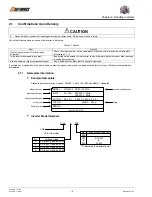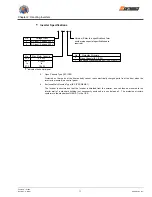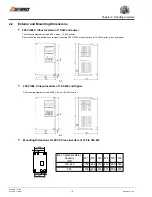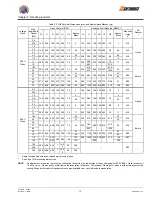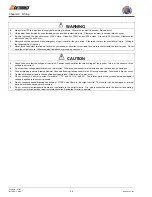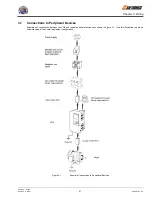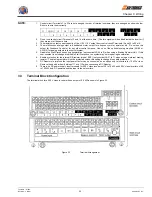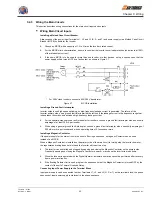
Chapter 3: Wiring
Firmware – S1043
Revision: 2 (9/98)
20
© Saftronics, Inc.
WARNING
•
Always turn OFF the input power supply before wiring terminals. Otherwise, an electric shock or fire can occur.
•
Wiring must be performed by an authorized person qualified in electrical work. Otherwise, an electric shock or fire can occur.
•
Be sure to ground the ground terminal. (200 V class: Ground to 100
Ω
or less, 400 V class: Ground to 10
Ω
or less) Otherwise, an
electric shock or fire can occur.
•
Always check the operation of any emergency stop circuits after they are wired. Otherwise, there is the possibility of injury. (Wiring is
the responsibility of the user)
•
Never touch the output terminals directly with your hands or allow the output lines to come into contact with the Inverter case. Never
short the output circuits. Otherwise, electrical shock or grounding can occur.
CAUTION
•
Check to be sure that the voltage of the main AC power supply satisfies the rated voltage of the Inverter. Injury or fire can occur if the
voltage is not correct.
•
Do not perform voltage withstand tests on the Inverter. Otherwise, semiconductor elements and other devices can be damaged.
•
Connect braking resistors, Braking Resistor Units, and Braking Units as shown in the I/O wiring examples. Otherwise, a fire can occur.
•
Tighten all terminal screws to the specified tightening torque. Otherwise a fire may occur.
•
Do not connect AC power to output Terminals T1, T2, and T3 (U, V, and W). The interior parts of the Inverter will be damaged if
voltage is applied to the output terminals.
•
Do not connect phase-advancing capacitors or LC/RC noise filters to the output circuits. The Inverter can be damaged or internal
parts burnt if these devices are connected.
•
Do not connect electromagnetic switches or contactors to the output circuits. If a load is connected while the Inverter is operating,
surge current will cause the overcurrent protection circuit inside the Inverter to operate.






